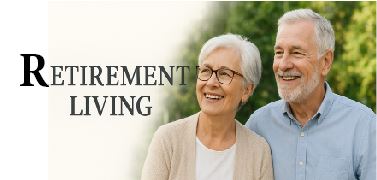Retirement Living

As we get older, it is of the utmost importance to keep your strength.
That does not meaning going to the gym…just easy daily activities can help you maintain strength, balance and flexibility to prevent falls and keep you moving.
Easy Daily Physical Activities
Walking:
A simple, accessible activity that improves cardiovascular health, strengthens muscles, and enhances balance.
Encourage short, frequent walks with friends or family for social interaction and motivation.
Gardening:
A great way to get gentle exercise, enjoy nature, and connect with the outdoors.
Dancing:
Fun, social, and a good way to improve balance and coordination.
Swimming:
A low-impact activity that’s easy on the joints, making it ideal for older adults.
Light Strength Training:
Use light weights, resistance bands, or bodyweight exercises to build muscle mass.
Yoga and Tai Chi:
These practices focus on flexibility, balance, and mindfulness, offering gentle ways to stay strong and mobile.
Recumbent Bike:
A stationary recumbent bike can provide a good leg workout with reduced risk of falls.
Tips for Success
Combine Activities:
Mix aerobic exercises, strength training, and balance activities to get a well-rounded workout.
Listen to Your Body:
Start slowly and make modifications as needed to avoid injury.
Make it Social:
Involve friends, neighbors, or family members to make activities more enjoyable and maintain connections.
Consider Group Activities:
Participate in walking groups, dance classes, or community sports to stay motivated and connected.

Retirement … What now?
After working hard for most of our lives, many of us may find adjusting to retirement difficult. Some people struggle to find a purpose to fill their days – but being retired doesn’t mean you have to sit around watching the world go by.
One of the joys of being retired is to have that option whenever you feel like it, but there’s also nothing to stop you staying active and involved in your family and community after you’ve retired.
Tips to stay productive in retirement
Have a daily routine
Establish a regular routine that keeps your mind and body active every day. Make sure your routine gets you out of your home and socialising with other people several times a week.
Find the natural rhythm of your retired day
For example, when do you sleep best, and when are you most active and alert? If you’re a night owl who has spent years getting early nights so that you could be fresh for a 9-to-5 job, you now have the freedom to adjust your sleeping and waking cycle to the hours that suit you best.
Explore hobbies and social pastimes
After you retire, you get to choose what you want to spend your time and energy on.

Estate living for the elderly offers independent or assisted housing within secure, community-focused environments that often include healthcare, leisure facilities, and amenities like restaurants and security. These estates can provide a tranquil atmosphere with like-minded individuals and a range of living options.
Benefits of Estate Living for the Elderly
Benefits
Security and Peace of Mind: Estates provide a secure, “lock-up-and-go” lifestyle, which is ideal for independent living.
Convenient Access to Healthcare: Many estates offer onsite or nearby healthcare facilities, ensuring residents have prompt access to care.
Community and Social Engagement: Residents live among like-minded individuals, fostering a sense of community and reducing isolation.
Amenities and Leisure
Estates often feature amenities such as restaurants, leisure facilities, and shops, promoting an active and convenient lifestyle.
Maintenance-Free Living: With many services included, residents can focus on enjoying their retirement without the burden of property maintenance.
Considerations
• Cost: The expense of living in a retirement estate can be high, and costs vary depending on the type of accommodation and care needed.
• Community Living:
Adapting to community living and potentially a smaller home requires adjustment for some individuals.
• Selling a Retirement Home:
Selling a retirement home can sometimes be complex, so understanding these processes is important.
Types of Estate Living
• Retirement Estates/Villages:
These offer a variety of living options, such as apartments and homes, within a secure estate environment.
• Mature Lifestyle Estates:
These are similar to retirement estates but focus on promoting an active lifestyle and healthy aging in a secure environment.
• Assisted Living Facilities:
These are specialized facilities for elderly residents who require more extensive support with daily activities.












